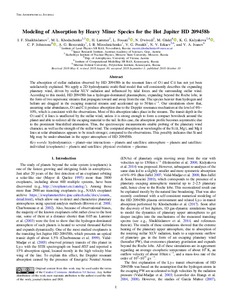Показать сокращенную информацию
Modeling of Absorption by Heavy Minor Species for the Hot Jupiter HD 209458b
| Автор | Shaikhislamov, I. F. | |
| Автор | Khodachenko, M. L. | |
| Автор | Lammer, H. | |
| Автор | Fossati, L. | |
| Автор | Dwivedi, N. | |
| Автор | Güdel, M. | |
| Автор | Kislyakova, K. G. | |
| Автор | Johnstone, C. P. | |
| Автор | Berezutsky, A. G. | |
| Автор | Miroshnichenko, I. B. | |
| Автор | Posukh, V. G. | |
| Автор | Erkaev, N. V. | |
| Автор | Ivanov, V. A. | |
| Дата внесения | 2020-01-20T08:04:27Z | |
| Дата, когда ресурс стал доступен | 2020-01-20T08:04:27Z | |
| Дата публикации | 2018-10 | |
| Библиографическое описание | Shaikhislamov, I. F. Modeling of Absorption by Heavy Minor Species for the Hot Jupiter HD 209458b [Текст] / I. F. Shaikhislamov, M. L. Khodachenko, H. Lammer, L. Fossati, N. Dwivedi, M. Güdel, K. G. Kislyakova, C. P. Johnstone, A. G. Berezutsky, I. B. Miroshnichenko, V. G. Posukh, N. V. Erkaev, V. A. Ivanov // Astrophysical Journal. — 2018. — Т. 866 (№ 1). | |
| ISSN | 0004637X | |
| URI (для ссылок/цитирований) | https://iopscience.iop.org/article/10.3847/1538-4357/aadf39/pdf | |
| URI (для ссылок/цитирований) | https://elib.sfu-kras.ru/handle/2311/129817 | |
| Аннотация | The absorption of stellar radiation observed by HD 209458b in the resonant lines of O I and C II has not yet been satisfactorily explained. We apply a 2D hydrodynamic multi-fluid model that self-consistently describes the expanding planetary wind, driven by stellar XUV radiation and influenced by tidal forces and the surrounding stellar wind. According to this model, HD 209458b has a hydrogen-dominated plasmasphere, expanding beyond the Roche lobe, in the form of two supersonic streams that propagate toward and away from the star. The species heavier than hydrogen and helium are dragged in the escaping material streams and accelerated up to 50 km s-1. Our simulations show that, assuming solar abundances, O I and C II produce absorption due to the Doppler resonance mechanism at the level of 6%-10%, which is consistent with the observations. Most of this absorption takes place in the streams. The transit depth in the O I and C II lines is unaffected by the stellar wind, unless it is strong enough to form a compact bowshock around the planet and able to redirect all the escaping material to the tail. In this case, the absorption profile becomes asymmetric due to the prominent blueshifted attenuation. Thus, the spectroscopic measurements enable probing of the planetary wind character, as well as the strength of the stellar wind. The computed absorption at wavelengths of the Si III, Mg I, and Mg II lines at solar abundances appears to be much stronger, compared to the observations. This possibly indicates that Si and Mg may be under-abundant in the upper atmosphere of HD 209458b. | |
| Тема | hydrodynamics | |
| Тема | planet–star interactions | |
| Тема | atmosphere | |
| Тема | individual: exoplanets | |
| Тема | physical evolution | |
| Тема | plasmas | |
| Название | Modeling of Absorption by Heavy Minor Species for the Hot Jupiter HD 209458b | |
| Тип | Journal Article | |
| Тип | Journal Article Preprint | |
| ГРНТИ | 41.23.21 | |
| Дата обновления | 2020-01-20T08:04:27Z | |
| DOI | 10.3847/1538-4357/aadf39 | |
| Институт | Политехнический институт | |
| Подразделение | Кафедра прикладной механики | |
| Журнал | Astrophysical Journal | |
| Квартиль журнала в Scopus | Q1 | |
| Квартиль журнала в Web of Science | Q1 |

